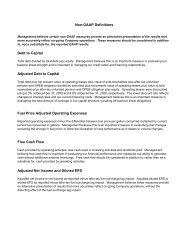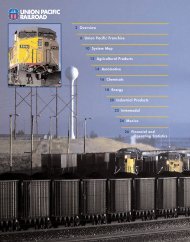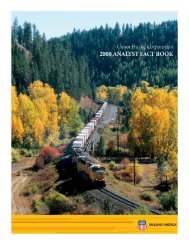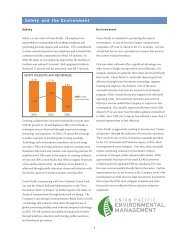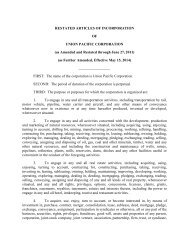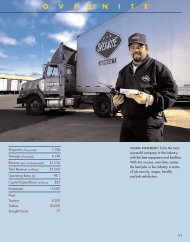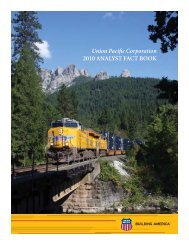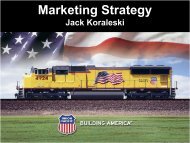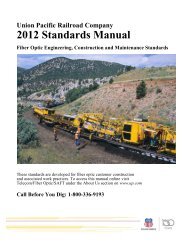Form 10-K - Union Pacific
Form 10-K - Union Pacific
Form 10-K - Union Pacific
Create successful ePaper yourself
Turn your PDF publications into a flip-book with our unique Google optimized e-Paper software.
Partnership Against Terrorism, a partnership designed to develop, enhance, and maintain effective<br />
security processes throughout the global supply chain.<br />
Cooperation with Customers and Trade Associations – Along with other railroads, we work with the<br />
American Chemistry Council to train more than 200,000 emergency responders each year. We work<br />
closely with our chemical shippers to establish plant security plans, and we continue to take steps to more<br />
closely monitor and track hazardous materials shipments. In cooperation with the Federal Railroad<br />
Administration (FRA) and other railroads, we are also working to develop additional improvements to tank<br />
car design that will further limit the risk of releases of hazardous materials.<br />
GOVERNMENTAL AND ENVIRONMENTAL REGULATION<br />
Governmental Regulation – Our operations are subject to a variety of federal, state, and local<br />
regulations, generally applicable to all businesses. (See also the discussion of certain regulatory<br />
proceedings in Legal Proceedings, Item 3.)<br />
The operations of the Railroad are also subject to the regulatory jurisdiction of the STB. The STB has<br />
jurisdiction over rates charged on certain regulated rail traffic; common carrier service of regulated traffic;<br />
freight car compensation; transfer, extension, or abandonment of rail lines; and acquisition of control of<br />
rail common carriers. The STB launched wide-ranging proceedings to explore whether to expand rail<br />
regulation, and we actively participated. The STB has not yet taken further action and denied a petition<br />
seeking one form of “access” regulation. Additionally, several bills were introduced in the U.S. Senate in<br />
early 2011 that would expand the regulatory authority of the STB and could include new antitrust<br />
provisions. We continue to monitor these proposed bills.<br />
The operations of the Railroad also are subject to the regulations of the FRA and other federal and state<br />
agencies. On January 12, 20<strong>10</strong>, the FRA issued final rules governing installation of Positive Train Control<br />
(PTC) by the end of 2015. Although still under development, PTC is a collision avoidance technology<br />
intended to override locomotive controls and stop a train before an accident. The FRA acknowledged that<br />
projected costs will exceed projected benefits by a ratio of about 22 to one, and we estimate that our<br />
costs will be higher than the FRA assumed. Congress has directed the FRA to provide an early report by<br />
March 1, 2012, on the status of PTC implementation, which is in advance of a detailed report due by the<br />
end of 2012. Through 2011, we have invested nearly $400 million in the development of PTC.<br />
DOT, the Occupational Safety and Health Administration, and DHS, along with other federal agencies,<br />
have jurisdiction over certain aspects of safety, movement of hazardous materials and hazardous waste,<br />
emissions requirements, and equipment standards. The Rail Safety Improvement Act of 2008, among<br />
other things, revised hours of service rules for train and certain other railroad employees, mandated<br />
implementation of PTC, imposed passenger service requirements, addressed safety at rail crossings,<br />
increased the number of safety related employees of the FRA, and increased fines that may be levied<br />
against railroads for safety violations. Additionally, various state and local agencies have jurisdiction over<br />
disposal of hazardous waste and seek to regulate movement of hazardous materials in ways not<br />
preempted by federal law.<br />
Environmental Regulation – We are subject to extensive federal and state environmental statutes and<br />
regulations pertaining to public health and the environment. The statutes and regulations are<br />
administered and monitored by the Environmental Protection Agency (EPA) and by various state<br />
environmental agencies. The primary laws affecting our operations are the Resource Conservation and<br />
Recovery Act, regulating the management and disposal of solid and hazardous wastes; the<br />
Comprehensive Environmental Response, Compensation, and Liability Act, regulating the cleanup of<br />
contaminated properties; the Clean Air Act, regulating air emissions; and the Clean Water Act, regulating<br />
waste water discharges.<br />
Information concerning environmental claims and contingencies and estimated remediation costs is set<br />
forth in Management’s Discussion and Analysis of Financial Condition and Results of Operations –<br />
Critical Accounting Policies – Environmental, Item 7 and Note 17 to the Consolidated Financial<br />
Statements in Item 8, Financial Statements and Supplementary Data.<br />
9



